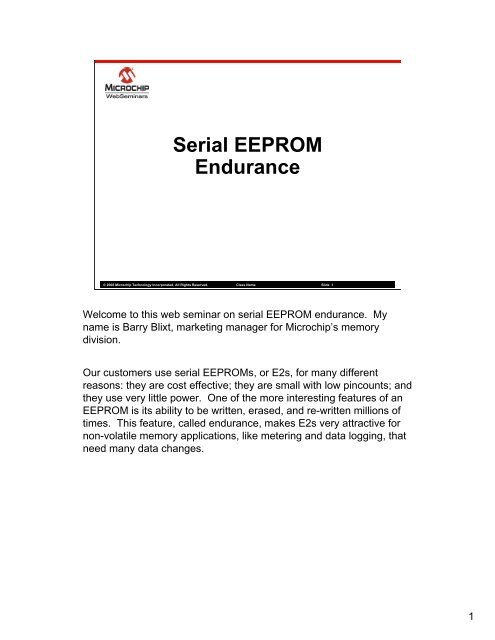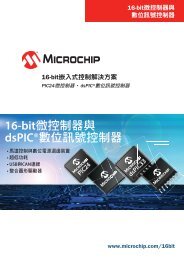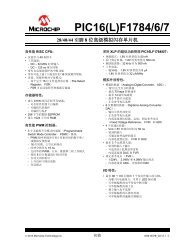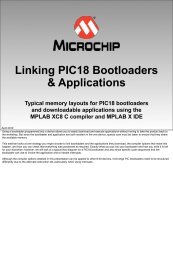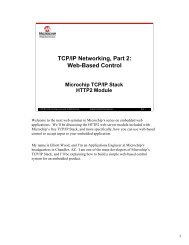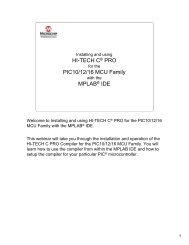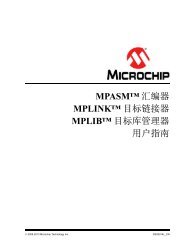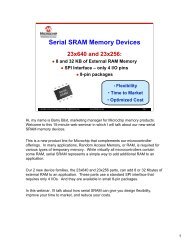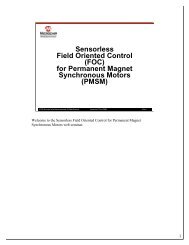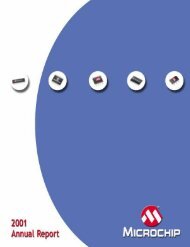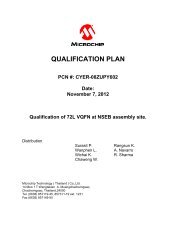Serial EEPROM Endurance - Microchip
Serial EEPROM Endurance - Microchip
Serial EEPROM Endurance - Microchip
Create successful ePaper yourself
Turn your PDF publications into a flip-book with our unique Google optimized e-Paper software.
<strong>Serial</strong> <strong>EEPROM</strong><br />
<strong>Endurance</strong><br />
© 2006 <strong>Microchip</strong> Technology Incorporated. All Rights Reserved. Class Name Slide 1<br />
Welcome to this web seminar on serial <strong>EEPROM</strong> endurance. My<br />
name is Barry Blixt, marketing manager for <strong>Microchip</strong>’s memory<br />
division.<br />
Our customers use serial <strong>EEPROM</strong>s, or E2s, for many different<br />
reasons: they are cost effective; they are small with low pincounts; and<br />
they use very little power. One of the more interesting features of an<br />
<strong>EEPROM</strong> is its ability to be written, erased, and re-written millions of<br />
times. This feature, called endurance, makes E2s very attractive for<br />
non-volatile memory applications, like metering and data logging, that<br />
need many data changes.<br />
1
Topics<br />
1. Defining terms<br />
2. Ways to improve endurance<br />
3. <strong>Microchip</strong>’s Total <strong>Endurance</strong>TM model<br />
4. Actual endurance data<br />
© 2006 <strong>Microchip</strong> Technology Incorporated. All Rights Reserved. <strong>EEPROM</strong> <strong>Endurance</strong> Slide 2<br />
This web seminar has 4 topics:<br />
We want you to understand <strong>Endurance</strong><br />
so you can make good design choices…<br />
First, we will define some important terms regarding endurance. We’ll also talk about the limitations<br />
of data sheet definitions.<br />
The second part of this web seminar will describe how designers can maximize <strong>EEPROM</strong> endurance<br />
in actual applications. This will include a description of how <strong>EEPROM</strong>s work and their typical failure<br />
mechanisms. A key point of this section is that endurance is very dependent on operating conditions.<br />
The third topic is an example problem using <strong>Microchip</strong>’s Total <strong>Endurance</strong> TM tool, a software model<br />
that calculates expected failure rates of <strong>Microchip</strong> <strong>EEPROM</strong>s given specific operating conditions.<br />
This tool is available for free on our web site.<br />
For the 4 th and final topic, I will share with you the results of some actual endurance testing we<br />
performed on several manufacturers’ <strong>EEPROM</strong>s.<br />
The overall purpose of this seminar is to give you a good understanding of endurance so that you can<br />
make good design choices.<br />
2
<strong>Endurance</strong>:<br />
� Erase/write cycles before failure<br />
© 2006 <strong>Microchip</strong> Technology Incorporated. All Rights Reserved. <strong>EEPROM</strong> <strong>Endurance</strong> Slide 3<br />
Let’s define some terms: <strong>Endurance</strong> is defined as the number of times that a memory device can<br />
be written and re-written before it fails to read back the proper data.<br />
3
<strong>Endurance</strong>:<br />
� Erase/write cycles before failure<br />
© 2006 <strong>Microchip</strong> Technology Incorporated. All Rights Reserved. <strong>EEPROM</strong> <strong>Endurance</strong> Slide 4<br />
Each programming cycle is usually referred to as an erase/write cycle, since virtually all<br />
<strong>EEPROM</strong>s include an automatic erase step before programming. Since E2s can be programmed<br />
down to the byte level, an erase/write cycle could be for as little as one byte to as much as a full<br />
page. We will see later how these different write modes have an effect on endurance.<br />
4
<strong>Endurance</strong>:<br />
� Erase/write cycles before failure<br />
© 2006 <strong>Microchip</strong> Technology Incorporated. All Rights Reserved. <strong>EEPROM</strong> <strong>Endurance</strong> Slide 5<br />
Failures occur because an <strong>EEPROM</strong> cell can wear out – but, this takes a long time, typically<br />
millions of cycles. Once even a single bit can no longer be reliably programmed, the entire<br />
device is defined to have failed.<br />
5
<strong>Endurance</strong>:<br />
� Erase/write cycles before failure<br />
Data Sheet<br />
� 1 M cycles, 25ºC<br />
� Limited usefulness<br />
© 2006 <strong>Microchip</strong> Technology Incorporated. All Rights Reserved. <strong>EEPROM</strong> <strong>Endurance</strong> Slide 6<br />
Another issue that needs some definition is how endurance is specified on data sheets.<br />
<strong>Microchip</strong>, as well as most other manufacturers, specifies endurance on its data sheets as 1<br />
million erase/write cycles at 25 degrees C.<br />
But what about endurance at other temperatures? What about 2 million or 3 million cycles? Can<br />
a designer expect zero fails before 1 million cycles, or just a small number? Do parts built by<br />
different manufacturers have similar endurance characteristics? Just using the data sheet does<br />
not give an engineer sufficient information to answer these questions.<br />
6
<strong>Endurance</strong>:<br />
� Erase/write cycles before failure<br />
Data Sheet<br />
� 1 M cycles, 25ºC<br />
� Limited usefulness<br />
Total <strong>Endurance</strong> TM s/w<br />
� Actual conditions<br />
� What-if analyses<br />
© 2006 <strong>Microchip</strong> Technology Incorporated. All Rights Reserved. <strong>EEPROM</strong> <strong>Endurance</strong> Slide 7<br />
That’s why we created the Total <strong>Endurance</strong> TM modeling software. The model calculates results<br />
based on the actual operating conditions that can have a major effect on endurance. The<br />
software also allows designers to create what-if scenarios to help in decision making.<br />
With that, let’s look at how <strong>EEPROM</strong>s work and what causes them to fail.<br />
7
Drain<br />
(Column)<br />
<strong>EEPROM</strong> Cell Structure<br />
Control Gate<br />
(Row)<br />
Floating Gate<br />
Substrate<br />
© 2006 <strong>Microchip</strong> Technology Incorporated. All Rights Reserved. <strong>EEPROM</strong> <strong>Endurance</strong> Slide 8<br />
Source<br />
A typical <strong>EEPROM</strong> cell contains 2 transistors, or gates. of how an <strong>EEPROM</strong> cell works, we can look<br />
at ways that a designer can get more cycles out of a device in a particular application.<br />
8
Thin Oxide<br />
Layer<br />
Drain<br />
(Column)<br />
<strong>EEPROM</strong> Cell Structure<br />
Control Gate<br />
(Row)<br />
Floating Gate<br />
Substrate<br />
© 2006 <strong>Microchip</strong> Technology Incorporated. All Rights Reserved. <strong>EEPROM</strong> <strong>Endurance</strong> Slide 9<br />
Source<br />
The floating gate is electrically isolated from the rest of the cell by a thin oxide layer.<br />
9
Thin Oxide<br />
Layer<br />
Drain<br />
(Column)<br />
<strong>EEPROM</strong> Cell Structure<br />
Control Gate<br />
(Row)<br />
Floating Gate<br />
Substrate<br />
© 2006 <strong>Microchip</strong> Technology Incorporated. All Rights Reserved. <strong>EEPROM</strong> <strong>Endurance</strong> Slide 10<br />
15-20 V<br />
Source<br />
To program the cell, a voltage differential is applied. A charge pump increases the 1.8 to 5.5 volt<br />
supply voltage up to 15 to 20 volts.<br />
10
Thin Oxide<br />
Layer<br />
0 V<br />
Drain<br />
(Column)<br />
<strong>EEPROM</strong> Cell Structure<br />
Control Gate<br />
(Row)<br />
Floating Gate<br />
Substrate<br />
© 2006 <strong>Microchip</strong> Technology Incorporated. All Rights Reserved. <strong>EEPROM</strong> <strong>Endurance</strong> Slide 11<br />
15-20 V<br />
Source<br />
If this high voltage is applied to the control gate, and the drain is connected to ground,<br />
11
Thin Oxide<br />
Layer<br />
0 V<br />
Drain<br />
(Column)<br />
<strong>EEPROM</strong> Cell Structure<br />
e -<br />
e -<br />
Control Gate<br />
(Row)<br />
Floating Gate<br />
e -<br />
Substrate<br />
© 2006 <strong>Microchip</strong> Technology Incorporated. All Rights Reserved. <strong>EEPROM</strong> <strong>Endurance</strong> Slide 12<br />
e -<br />
e -<br />
e -<br />
e -<br />
e -<br />
15-20 V<br />
Source<br />
electrons will move from the substrate, though the thin oxide layer, and onto the floating gate, giving it<br />
a negative charge.<br />
12
Thin Oxide<br />
Layer<br />
0 V<br />
Drain<br />
(Column)<br />
<strong>EEPROM</strong> Cell Structure<br />
e -<br />
e -<br />
Control Gate<br />
(Row)<br />
Floating Gate<br />
e -<br />
Substrate<br />
© 2006 <strong>Microchip</strong> Technology Incorporated. All Rights Reserved. <strong>EEPROM</strong> <strong>Endurance</strong> Slide 13<br />
e -<br />
e -<br />
e -<br />
e -<br />
e -<br />
15-20 V<br />
Fowler-<br />
Nordheim<br />
Tunneling<br />
Source<br />
This is a quantum-mechanical process known as Fowler-Nordheim tunneling. The key to this<br />
tunneling is that the electrons barely disturb the oxide layer, so the process can be repeated millions<br />
of times. A flash cell uses a different programming technique, called Channel Hot Electron<br />
Programming, that damages the oxide layer with every write. That’s why E2’s have much higher<br />
endurance than flash, which is usually specified to only 10,000 cycles.<br />
Reversing the voltage differential causes negatively-charged electrons to leave the floating gate and<br />
move back into the substrate, leaving the gate with a lack of electrons and a positive charge. This<br />
charge on the floating gate determines if the cell, or bit, is a 1 or a zero. If the voltage differential is<br />
removed, the electrons stay where they are. Since the floating gate keeps its positive or negative<br />
charge when the power is turned off, the <strong>EEPROM</strong> is non-volatile.<br />
An <strong>EEPROM</strong> cell fails when the built-in sensing circuitry can no longer determine the charge on the<br />
floating gate. After many erase/write cycles, field stresses and the constant tunneling through the thin<br />
oxide layer begin to reduce the voltage differential. Also, the thin oxide can begin to leak charge from<br />
the floating gate, so the cell is no longer non-volatile. In any of these failure modes, a sense amp can<br />
no longer tell the difference between a 1 or a zero.<br />
So, obviously an important part of endurance is the intrinsic structure of the cell. <strong>Microchip</strong>’s<br />
<strong>EEPROM</strong> cell was designed to maximize the amount of endurance available.<br />
But it’s not all about the cell structure. Now that we understand the mechanics of how an <strong>EEPROM</strong><br />
cell works, we can look at ways that a designer can get more cycles out of a device in a particular<br />
application.<br />
13
3. DATA OPTIONS<br />
• Minimize writes<br />
Key Effects on <strong>Endurance</strong><br />
1. TEMPERATURE & VOLTAGE<br />
• Lower is Better<br />
2. WRITE MODE<br />
• Page Mode is Better<br />
© 2006 <strong>Microchip</strong> Technology Incorporated. All Rights Reserved. <strong>EEPROM</strong> <strong>Endurance</strong> Slide 14<br />
There are 3 major effects on endurance that designers need to be aware of.<br />
The first is the operating conditions of the application. Our research has shown that<br />
higher temperatures and voltages cause faster wear out of the cell. To maximize<br />
endurance, designers should choose the lowest operating temperature and voltage<br />
possible.<br />
The second key effect on endurance is the choice of write mode. When a single<br />
byte is programmed, the energy from the charge pump is concentrated on that one<br />
byte. If a page write is used, that energy is dissipated over more bytes, so cell wear<br />
is decreased. <strong>Microchip</strong> builds in circuitry to minimize the wear effect of byte writes,<br />
but overall, designers should use Page mode whenever possible.<br />
The third endurance effect is the designer’s choice of how often he programs the<br />
data. Writing as infrequently as possible will lengthen the device’s life.<br />
We’ll see the effects of changing these parameters in the example of our modeling<br />
software. Let’s look at the model now.<br />
14
© 2006 <strong>Microchip</strong> Technology Incorporated. All Rights Reserved. <strong>EEPROM</strong> <strong>Endurance</strong> Slide 15<br />
Here is a screen shot of the Total <strong>Endurance</strong> TM interface.<br />
15
Devices<br />
© 2006 <strong>Microchip</strong> Technology Incorporated. All Rights Reserved. <strong>EEPROM</strong> <strong>Endurance</strong> Slide 16<br />
First, you can pick the <strong>Microchip</strong> device that you want to model. All <strong>Microchip</strong><br />
memory devices are included, and we add new devices when they are released.<br />
16
Inputs<br />
© 2006 <strong>Microchip</strong> Technology Incorporated. All Rights Reserved. <strong>EEPROM</strong> <strong>Endurance</strong> Slide 17<br />
Next, you can enter your application’s actual operating conditions. Since endurance<br />
is impacted by voltage, temperature, and how the part is programmed, this input<br />
section is really the key to the whole model. It is very easy to change a parameter.<br />
17
Options<br />
© 2006 <strong>Microchip</strong> Technology Incorporated. All Rights Reserved. <strong>EEPROM</strong> <strong>Endurance</strong> Slide 18<br />
The options section, shown here, lets you select how you want to see the results.<br />
18
Results<br />
© 2006 <strong>Microchip</strong> Technology Incorporated. All Rights Reserved. <strong>EEPROM</strong> <strong>Endurance</strong> Slide 19<br />
Finally, the results section shows endurance data in both numerical and graphical<br />
format. This data can be exported to spreadsheet or presentation software.<br />
Now, let’s look at an example problem.<br />
19
85º C<br />
600 miles<br />
per day<br />
Truck Odometer Example:<br />
Goal:
Truck Odometer Options:<br />
Goal:
www.microchip.com<br />
© 2006 <strong>Microchip</strong> Technology Incorporated. All Rights Reserved. <strong>EEPROM</strong> <strong>Endurance</strong> Slide 22<br />
We have more information on <strong>EEPROM</strong>s and endurance on our web site.<br />
22
www.microchip.com<br />
� Download Total <strong>Endurance</strong> TM model<br />
� Search “Total <strong>Endurance</strong>”<br />
© 2006 <strong>Microchip</strong> Technology Incorporated. All Rights Reserved. <strong>EEPROM</strong> <strong>Endurance</strong> Slide 23<br />
I encourage you to download the Total <strong>Endurance</strong> TM software. It’s free, and easy to<br />
access. Just go to www.microchip.com and search for “total endurance.”<br />
Once you’ve downloaded the model, check out both the FAQs and the Tutorial that<br />
are available in the Help menus. There is a more detailed discussion about<br />
common endurance misconceptions, cell design, failure mechanisms, and how our<br />
engineers developed the model.<br />
23
www.microchip.com<br />
� Download Total <strong>Endurance</strong> TM model<br />
� Search “Total <strong>Endurance</strong>”<br />
� More information on <strong>Endurance</strong><br />
1. AN 1019: <strong>Endurance</strong> Tutorial<br />
2. AN 562: Using Total <strong>Endurance</strong> S/W<br />
© 2006 <strong>Microchip</strong> Technology Incorporated. All Rights Reserved. <strong>EEPROM</strong> <strong>Endurance</strong> Slide 24<br />
We have two excellent app notes about endurance on our web site. The first – AN<br />
1019 – describes endurance in more detail. The second – AN 562 – has more hints<br />
about how to use the Total <strong>Endurance</strong> tool.<br />
24
www.microchip.com<br />
� Download Total <strong>Endurance</strong> TM model<br />
� Search “Total <strong>Endurance</strong>”<br />
� More information on <strong>Endurance</strong><br />
1. AN 1019: <strong>Endurance</strong> Tutorial<br />
2. AN 562: Using Total <strong>Endurance</strong> S/W<br />
� Other memory web seminars<br />
© 2006 <strong>Microchip</strong> Technology Incorporated. All Rights Reserved. <strong>EEPROM</strong> <strong>Endurance</strong> Slide 25<br />
We also have two other web seminars on serial E2s: an introduction to serial<br />
<strong>EEPROM</strong>s and an introduction to our SEEVAL® 32 developers kit.<br />
25
www.microchip.com<br />
� Download Total <strong>Endurance</strong> TM model<br />
� Search “Total <strong>Endurance</strong>”<br />
� More information on <strong>Endurance</strong><br />
1. AN 1019: <strong>Endurance</strong> Tutorial<br />
2. AN 562: Using Total <strong>Endurance</strong> S/W<br />
� Other memory web seminars<br />
� One more thing…<br />
© 2006 <strong>Microchip</strong> Technology Incorporated. All Rights Reserved. <strong>EEPROM</strong> <strong>Endurance</strong> Slide 26<br />
One last issue: I mentioned that the Total <strong>Endurance</strong> model is only good for<br />
<strong>Microchip</strong> devices. Next, I want to address one more question: are all suppliers’<br />
<strong>EEPROM</strong>s the same?<br />
26
% Fails<br />
100%<br />
80%<br />
60%<br />
40%<br />
20%<br />
<strong>Endurance</strong> Test Results:<br />
3 Manufacturers<br />
0 500,000 1,000,000 1,500,000 2,000,000<br />
Erase/write cycles at 85º C<br />
© 2006 <strong>Microchip</strong> Technology Incorporated. All Rights Reserved. <strong>EEPROM</strong> <strong>Endurance</strong> Slide 27<br />
You now know enough about endurance to predict that <strong>EEPROM</strong>s from different suppliers, and, therefore, from different manufacturing processes, will<br />
have very different endurance characteristics. To confirm that theory, <strong>Microchip</strong> recently performed some actual, destructive endurance testing on<br />
several different manufacturers’ devices, including our own. I’ll show you the results from 3 manufacturers on this slide. In all cases, the device’s<br />
data sheet specified 1 million erase/write cycles.<br />
First a word on the test methodology. We purchased all competitors’ parts through commercial web sites; we ordered standard <strong>Microchip</strong> parts from<br />
our own sample center. We tested 128 <strong>EEPROM</strong>s from each manufacturer, each a 16-kbit, I 2C TM device. The parts were cycled 2 million times<br />
using a random data pattern. We cycled at a high temperature – 85 deg C – in order to accelerate wear and speed up the test. Each part was<br />
read every 100,000 cycles to see if it had failed, that is, if one or more bits were incorrect. We used PDIP packages, wrote in page mode, and<br />
operated at 5.5 volts.<br />
Notice that the empty graph now on the slide looks a lot like the Total <strong>Endurance</strong> TM graphical output. The major differences are 1) the y-axis here is in<br />
percent fails not ppm and 2) while the Total <strong>Endurance</strong> tool is a model, this data is based on actual cycling.<br />
27
% Fails<br />
100%<br />
80%<br />
60%<br />
40%<br />
20%<br />
1 st read<br />
point<br />
<strong>Endurance</strong> Test Results:<br />
3 Manufacturers<br />
0 500,000 1,000,000 1,500,000 2,000,000<br />
Erase/write cycles at 85º C<br />
© 2006 <strong>Microchip</strong> Technology Incorporated. All Rights Reserved. <strong>EEPROM</strong> <strong>Endurance</strong> Slide 28<br />
Here are the results from the first read point for supplier number 1. After only 100,000 cycles, there were already some failing parts.<br />
28
% Fails<br />
100%<br />
80%<br />
60%<br />
40%<br />
20%<br />
<strong>Endurance</strong> Test Results:<br />
3 Manufacturers<br />
2 nd read<br />
point<br />
0 500,000 1,000,000 1,500,000 2,000,000<br />
Erase/write cycles at 85º C<br />
© 2006 <strong>Microchip</strong> Technology Incorporated. All Rights Reserved. <strong>EEPROM</strong> <strong>Endurance</strong> Slide 29<br />
Now I will add data from the 2nd read point, at 200,000 cycles. There are more fails, on the order of 2%, But, 2% means 20,000 ppm!<br />
29
% Fails<br />
100%<br />
80%<br />
60%<br />
40%<br />
20%<br />
<strong>Endurance</strong> Test Results:<br />
3 Manufacturers<br />
0 500,000 1,000,000 1,500,000 2,000,000<br />
Erase/write cycles at 85º C<br />
© 2006 <strong>Microchip</strong> Technology Incorporated. All Rights Reserved. <strong>EEPROM</strong> <strong>Endurance</strong> Slide 30<br />
100%<br />
fails<br />
Here is the rest of the test data for the first supplier. By the end of the test, 100% of the 128 units that we tested failed. This is a very harsh test<br />
environment, well above the data sheet specification, but the results are not very impressive.<br />
30
% Fails<br />
100%<br />
80%<br />
60%<br />
40%<br />
20%<br />
<strong>Endurance</strong> Test Results:<br />
3 Manufacturers<br />
0 500,000 1,000,000 1,500,000 2,000,000<br />
Erase/write cycles at 85º C<br />
© 2006 <strong>Microchip</strong> Technology Incorporated. All Rights Reserved. <strong>EEPROM</strong> <strong>Endurance</strong> Slide 31<br />
This 2nd vendor had better results. Still, after the 2-million cycle test, 20% of the units had failed.<br />
100%<br />
fails<br />
31
% Fails<br />
100%<br />
80%<br />
60%<br />
40%<br />
20%<br />
Early<br />
fails<br />
<strong>Endurance</strong> Test Results:<br />
3 Manufacturers<br />
0 500,000 1,000,000 1,500,000 2,000,000<br />
Erase/write cycles at 85º C<br />
© 2006 <strong>Microchip</strong> Technology Incorporated. All Rights Reserved. <strong>EEPROM</strong> <strong>Endurance</strong> Slide 32<br />
100%<br />
fails<br />
And, note that both these suppliers exhibited several early fails before the first read point of 100,000 cycles. Eliminating these early fails is crucial,<br />
since most applications never reach millions of cycles.<br />
32
% Fails<br />
100%<br />
80%<br />
60%<br />
40%<br />
20%<br />
Early<br />
fails<br />
<strong>Endurance</strong> Test Results:<br />
3 Manufacturers<br />
0 500,000 1,000,000 1,500,000 2,000,000<br />
Erase/write cycles at 85º C<br />
© 2006 <strong>Microchip</strong> Technology Incorporated. All Rights Reserved. <strong>EEPROM</strong> <strong>Endurance</strong> Slide 33<br />
100%<br />
fails<br />
<strong>Microchip</strong>: 0 fails<br />
Finally, I will add the <strong>Microchip</strong> results. <strong>Microchip</strong> devices showed no fails throughout the entire test. Now that the 3 curves are on the graph, you can<br />
really see the drastic differences in endurance results. We make the following 3 conclusions from this data:<br />
1. <strong>EEPROM</strong>S made by different manufacturers can have drastically different endurance characteristics<br />
2. All these parts were specified to 1 million cycles. Data sheet definitions are not enough to make good decisions in harsh conditions.<br />
3. This test emphasizes <strong>Microchip</strong>’s reputation of having excellent endurance<br />
To expand on that last point, we at <strong>Microchip</strong> are very proud of our endurance. We spend a lot of resources designing parts that will have excellent<br />
endurance, and we also use extensive testing to reduce early fails and ensure outgoing quality. Even if your application does not need millions of<br />
cycles, you can be assured that <strong>Microchip</strong> parts are built and tested to the highest quality.<br />
33
<strong>EEPROM</strong> <strong>Endurance</strong><br />
� Definitions and Education<br />
� Ways to improve endurance<br />
� Total <strong>Endurance</strong> TM software<br />
� <strong>Endurance</strong> testing<br />
Thanks!<br />
© 2006 <strong>Microchip</strong> Technology Incorporated. All Rights Reserved. <strong>EEPROM</strong> <strong>Endurance</strong> Slide 34<br />
And that concludes this web seminar. Let’s review the major topics we covered.<br />
We had a quick review of endurance and defined some key terms, including a warning about how<br />
data sheet definitions can be incomplete.<br />
Then we talked about the cell structure of <strong>EEPROM</strong>s and some ways that engineers can increase<br />
endurance in specific applications.<br />
We completed an example case using our Total <strong>Endurance</strong> TM software, highlighting how quick and<br />
easy it is to make design decisions.<br />
Finally, we just looked at some endurance data from different suppliers that emphasized the<br />
differences among products.<br />
Our goal is to help you understand <strong>EEPROM</strong> endurance so you can make good design decisions.<br />
The centerpiece of that education is the Total <strong>Endurance</strong> software – the only model of its type in the<br />
industry.<br />
Thanks very much for your time.<br />
34


